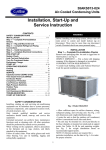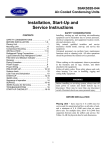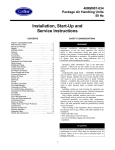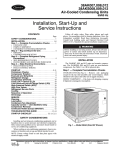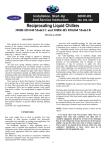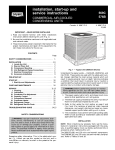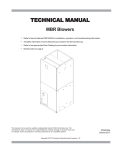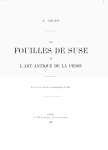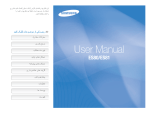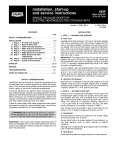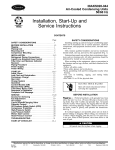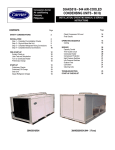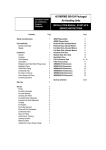Download Carrier 38AK008 Troubleshooting guide
Transcript
38AK008,009,012 Air-Cooled Condensing Units 50 Hz Installation, Start-Up and Service Instructions CONTENTS SAFETY CONSIDERATIONS Page SAFETY CONSIDERATIONS . . . . . . . . . . . .. . . . . . . . . 1 INSTALLATION . . . . . . . . . . . . . . . . . . . . . . . ... . . . . . 1-6 Step 1 — Complete Pre-Installation Checks . . ……. . . . 1 • UNCRATE UNIT • INSPECT SHIPMENT • CONSIDER SYSTEM REQUIREMENTS Step 2 — Complete Refrigerant Piping Connections . . . . . . . . . . . . . . . . . . . . . . . . . . . .... . . . . . . . 4 • SIZE REFRIGERANT LINES • FILTER DRIER AND MOISTURE INDICATOR Step 3 — Make Electrical Connections . . . . . . . . …... . . 5 • FIELD POWER SUPPLY • FIELD CONTROL WIRING START-UP . . . . . . . . . . . . . . . . . . . . . . . . . . . . . . . . . . 7-8 Preliminary Checks . . . . . . . . . . . . . . . . . . . . . . . . . . . . . 7 Compressor Rotation . . . . . . . . . . . . . . . . . . . . . . .. . . . . 7 Evacuate and Dehydrate . . …………………………...... 7 Refrigerant Charge. . . . . . . . . . . . . . . . . . . . . .. . . . . . . . 7 Low-Pressure/Loss-of-Charge Switch (LPS). . ……. . . 7 High-Pressure Switch (HPS). . . . . . . . . . . . . ... . . . . . . . 7 Refrigerant Service Ports . . . . . . . . . . . . . . . . ... . . . . . . 7 Cooling . . . . . . . . . . . . . . . . . . . . . . . . . . . .. . . . . . . . . . . . 7 Sequence of Operation. . . . . . . . . . . . . . . . . . . ... . . . . . . 8 Oil Charge. . . . . . . . . . . . . . . . . . . . . …… .. . . . . . . . . . 8 SERVICE . . . . . . . . . . . . . . . . . . . . . . . . . . . . . . . . . . . 8-9 Cleaning . . . . . . . . . . . . . . . . . . . . . . .. . . . . . . . . . . .. . . . 8 Lubrication. . . . . . . . . . . . . . . . . . . . .. . . . . . . . . .. . . . . . 8 Condenser-Fan Adjustment . . . . . . . . . . . . . . ….. . . . . 8 Compressor Removal . . . . . . . . . . . . . . . . . . . …. . . . . . 9 Crankcase Heater ……………………. . . . . . ….. . . . . . 9 TROUBLESHOOTING GUIDE . . . . . . . . . . . . . . . . 10 START-UP CHECKLIST . . . . . . . . . . . . . .. . 11-12 Installing and servicing air-conditioning equipment can be hazardous due to system pressure and electrical components. Only trained and qualified service personnel should install or service air-conditioning equipment. When working on air-conditioning equipment, observe precautions in literature and on tags and labels attached to unit. Follow all safety codes. Wear safety glasses and work gloves. Use quenching cloth for brazing operations. Have fire extinguisher available. Read these instructions thoroughly. Consult local building codes and National Electrical Code(NEC) (U.S.A. Standard) for special installation requirements. WARNING Before installing or servicing system, always turn off main power to system and install lockout tag on disconnect. There may be more than one disconnect switch. Electrical shock can cause personal injury. INSTALLATION The 38AK008, 009, and 012 units use hermetic compressors. See Table 1A or 1B for physical data. Step 1 — Complete Pre-Installation Checks UNCRATE UNIT — Remove unit packaging except for the top, which should be left in place until after unit is rigged into place. INSPECT SHIPMENT — File claim with shipping company if shipment is damaged. 1 Table 1A — Physical Data — English UNIT 38AK 008 009 012 Aluminum Coils (Standard) 510 564 564 Copper Coils (Optional) 578 632 632 Aluminum Coils (Standard) 560 614 614 Copper Coils (Optional) 628 682 682 OPERATING WEIGHT (lb) RIGGING WEIGHT (lb) REFRIGERANT R-22 COMPRESSOR Copeland , Scroll Quantity … Model 1…ZR94KC Quantity Cylinders - Speed (rpm) Oil charge (oz) 1…ZR125KC - 2900 2900 85 110 CONDENSER FAN 2900 66 Propeller; Direct Drive Quantity … RPM 1…900 Diameter (in.) 26 ⅓ Motor Hp (NEMA) Nominal Airflow (cfm) 2…ZR61KC 5400 5400 CONDENSER COIL 5400 Copper Tubes, Aluminum Fins Face Area (sq ft) 18.0 18.0 18.0 Storage Capacity (lb)† 16.56 16.56 16.56 1⅛ 1⅛ 1⅛ ½ ⅝ ½ CONNECTIONS (sweat) Suction (in.) Liquid (in.) CONTROLS Pressure stat Settings (psig) High Low Cutout 426 ± 7 Cut-in 320 ± 20 Cutout 27 ± 4 Cut-in 60 ± 5 2 Table 1B — Physical Data — SI UNIT 38AK 008 009 012 Aluminum Coils (Standard) 231 256 256 Copper Coils (Optional) 262 287 287 Aluminum Coils (Standard) 254 279 279 Copper Coils (Optional) 285 309 309 OPERATING WEIGHT (kg) RIGGING WEIGHT (kg) REFRIGERANT R-22 COMPRESSOR Copeland, Scroll Quantity … Model 1…ZR94KC 1…ZR125KC 2…ZR61KC Quantity Cylinders - - - Speed (r/s) 58.2 58.2 58.2 Oil charge (L) 2.50 3.25 1.95 CONDENSER FAN Propeller; Direct Drive Quantity … r/s 1…15.0 Diameter (mm) 660 ⅓ Motor Hp (NEMA) Nominal Airflow (L/s) 2550 2550 CONDENSER COIL 2550 Copper Tubes, Aluminum Fins Face Area (sq m) 1.67 1.67 1.67 Storage Capacity (kg)† 7.5 7.5 7.5 1⅛ 1⅛ 1⅛ ½ ⅝ ½ CONNECTIONS (sweat) Suction (in.) Liquid (in.) CONTROLS Pressure stat Settings (kPa) High Low Cutout 2937 ± 48 Cut-in 2206 ± 138 Cutout 186 ± 27 Cut-in 413 ± 103 3 Step 2 — Complete Refrigerant Piping Connections— Suction connection is sweat with liquid connection is sweat. Refer to Table 3 for the proper line sizes. Follow standard Piping practices. SIZE REFRIGERANT LINES — Consider length of piping Required between condensing unit and air handler, amount of liquid lift, and compressor oil return. See Table 3 and also refer to Part 3 of Carrier System Design Manual for design details and line sizing. Refer to air handler installation instructions for additional information. CONSIDER SYSTEM REQUIREMENTS • Consult local building codes and NEC for special installation requirements. • Allow sufficient space for airflow clearance, wiring, refrigerant piping, and unit servicing. See Fig. 1. • Locate unit so that condenser airflow is unrestricted on all sides and above. Refer to Fig. 1. • Unit may be mounted on a level pad directly on base rails or mounted on raised pads at support points. SeeTable 2 for weight distribution based on recommended support points. NOTE: If vibration isolators are required for a particular installation, use corner weight information in Table 2 to make proper selection. Table 3 — Refrigerant Piping Sizes Table 2 — Weight Distribution UNIT 38AK 008 009,012 008 009,012 STD UNIT Lb Kg 392 426 177 192 460 503 208 215 CORNER CORNER W X Lb Kg Lb Kg With Aluminum Coil CORNER Y Lb Kg CORNER Z Lb Kg 35 42 99 109 45 49 107 105 49 48 With Copper Coil 114 52 95 43 118 53 116 53 108 119 49 54 121 119 55 54 86 89 39 40 78 92 UNIT 38AK 008 009 012 LINERA LENGTH OF PIPING – FT (M) 0-25 25-50 50-75 (0-7.6) (7.6-15.2) (15.2-22.9) L S L S L S ⅝ ½ 1⅛ ½ 1⅛ 1⅜ ⅝ ⅝ ⅝ 1⅛ 1⅛ 1⅜ ½ ½ ⅝ 1⅛ 1⅛ 1⅜ 75-100 (22.9-30.5) L S ⅝ 1⅜ ⅝ 1⅜ ⅝ 1⅜ LEGEND L — Liquid Line S — Suction Line NOTES: 1. Pipe sizes are based on a 2 F (1 C) loss for liquid and suction Lines. 2. Pipe sizes are based on the maximum linear length shown for each column, plus a 50% allowance for fittings. 3. Charge units with R-22 in accordance with unit installation Instructions. 4. Line size conversion to mm is: in. mm ½ 12.7 ⅝ 15.9 1⅛ 28.6 1⅜ 34.9 Fig. 1 UNIT 38AK 008 009 012 RIGGING EIGHT* lb kg 560 254 614 279 614 279 A In. 45.0 45.0 45.0 B mm 1143 1143 1143 In. 38.5 38.5 38.5 C mm 978 978 978 In. 43.5 43.5 43.5 mm 1105 1105 1105 *Weights are for aluminum coils. 4 FILTER DRIER AND MOISTURE INDICATOR — Moisture indicator and filter drier should be installed in liquid line. Do not use a receiver; there is none provided with unit and one should not be used. NOTE: System pressure must be relieved before removing caps. Recover refrigerant prior to brazing. Pass nitrogen or other inert gas through piping while brazing to prevent formation of copper oxide. It should be that a liquid line solenoid valve will be positioned in the main liquid line close to the evaporator coil, and wired to close when compressor stops to minimize refrigerant migration during the ‘‘OFF’’ cycle. Step 3 — Make Electrical Connections Table 4 – Liquid Line Data – 50Hz FIELD POWER SUPPLY — All units except 208/230-v units are factory wired for the voltage shown on the nameplate. If the 208/230-v unit is to be connected to a 208v power supply, the transformer must be rewired by moving the black wire from the 230-v 1/4-in. spade terminal on the transformer and connecting it to the 200-v 1/4-in. spade terminal from the transformer. When installing units, provide a disconnect per NEC. All field wiring must comply with NEC and local requirements. Install field wiring as follows: 1. Install conduit through side panel openings. 2. Install power lines to connections.Wrap connections with electrical tape. Voltage to compressor terminals during operation must be within voltage range indicated on unit nameplate (also see Table5). Voltages between phases must be balanced within 2% and the current within 10%. Use the formula shown in Table 5,Note 2, to determine the percent voltage imbalance Operation on improper line voltage or excessive phase imbalance constitutes abuse and may cause damage to electrical components. UNIT 38AK 008 009 012 MAX ALLOWABLE LIQUID LIFT Ft M 50 15.2 52 15.8 52 17.4 CATION Unit cabinet must have an uninterrupted, unbroken electrical Ground to minimize the possibility of personal injury if an electrical fault should occur. This ground may consist of electrical wire connected to unit ground lug in control compartment, or conduit approved for electrical ground when installed in accordance with NEC ANSI (American National Standards Institute)/NFPA (National Fire Protection Association) 70 (U.S.A. Standards) and local electrical codes. Failure to follow this warning could result in the installer being liable for personal injury of others. LIQUID LINE Max Allowable Max Allowable pressure Drop Temp Loss psi kpa F C 7 48.3 2 1 7 48.3 2 1 7 48.3 2 1 NOTE: Values shown are for units operating at 45 F (7.2 C) saturated suction and 95 F (35 C) entering air. 5 Table 5 – Electrical Data UNIT 38AK 008 009 012 NOMINAL VOLTAGE (V-ph-Hz) 220-3-50 400-3-50 220-3-50 400-3-50 220-3-50 400-3-50 VOLTAGE RANGE MIN MAX 198 242 360 440 198 242 360 440 198 242 360 440 LEGEND COMPRESSOR RLA LRA 31.5 160 15.7 80 39.7 198 19.9 99 39.7 198 19.9 99 = 100 × FLA — Full Load Amps HACR — Heating, Air Conditioning and Refrigeration LRA — Locked Rotor Amps MCA — Minimum Circuit Amps MOCP — Maximum Over current Protection NEC — National Electrical Code (U.S.A. Standard) OFM — Outdoor (Condenser) Fan Motor RLA — Rated Load Amps OFM FLA 1.4 1.4 1.4 1.4 1.4 1.4 POWER SUPPLY MCA MOCP 42.5 50 21.0 25 52.7 70 26.3 35 52.7 70 26.3 35 Max voltage deviation from average voltage Average voltage Example: Supply voltage is 460-3-60. AB = 243v BC = 236v AC = 238v Average Voltage = = NOTES: 1. In compliance with NEC requirements for multicolor and combination load equipment (refer to NEC Articles 430 and 440), the over current protective device for the unit shall be fuse or HACR breaker. 2. Unbalanced 3-Phase Supply Voltage Never operate a motor where a phase imbalance in supply voltage is greater than 2%. Use the following formula to determine the percent of voltage imbalance. IMPORTABNT: if the supply voltage phase imbalance is more than 2% contact your local electric utility company immediately. FIELD CONTROL WIRING — Install a accessory thermostat assembly according to installation instructions included with the accessory. Locate thermostat assembly on a solid wall in the conditioned space to sense average temperature in accordance with thermostat installation instructions. Route thermostat cable or equivalent single leads of colored Wire from sub base terminals to low-voltage connections on Unit as described in Steps 1 through 3 below. 425+464+455 3 1371 = 457 3 Determine maximum deviation from average voltage. (AB) 457 – 452 = 5 v (BC) 464 – 457 = 7 v (AC) 457 – 455 = 2 v Maximum deviation is 7 v. Determine percent of voltage imbalance. 7 % voltage imbalance = 100 × = 1.53% 457 This amount of phase imbalance is satisfactory as it is below the maximum allowable 2%. NOTE: For wire runs, use the following insulated wire: LENGHT INSULATION RATING(C) Ft M 0-50 0-15.2 35 50-75 15.2-22.9 35 Over 75 Over 22.9 35 LEGEND AWG — American Wire Gage All wire larger than no. 18 AWG cannot be directly connected to the thermostat and will require a junction box and splice at the thermostat. 1. Connect thermostat wires to screw terminals of low voltage Connection board. 2. Pass the control wires through the hole provided in the Corner post. 3. Feed wire through the raceway built into the corner post SIZE AWG 18 16 14 Sq mm 0.82 1.30 2.08 and into the 24 v thermostat connection board. The 24 thermostat connection is located on the left side of the lowvoltage connection compartment. The raceway provides the UL required clearance between high- and lowvoltagewiring. Total combined amperage drain of the field-installed liquid line solenoid valve and indoor (evaporator) fan contactor must not exceed 22 va. If the specified va must be exceeded, use a remote relay to switch the load. 6 START-UP affect the reading. Indoor airflow must be within the normal operating range of the unit. Operate unit a minimum of 15 minutes. Ensure pressure and temperature readings have stabilized. Plot liquid pressure and temperature on chart and add or reduce charge to meet curve. Adjust charge to conform with charging chart, using liquid pressure and temperature to read chart. Preliminary Checks 1. Field electrical power source must agree with unit nameplate acting. 2. Check that all internal wiring connections are tight and hat all barriers, covers, and panels are in place. Ensure no electrical wires are in contact with refrigerant tubing. 3. Ensure all service valves are open. Be sure all compressor service valves are back seated. 4. Verify compressor crankcase heater is securely in place. Crankcase heater must operate for at least 24 hours before start-up. 5. Check for leaks in refrigerant system by using soap bubbles and/or electronic leak detector. 6. Check that liquid line solenoid valve is located at evaporator coil as shown in Filter Drier and Moisture Indicator section, page 5. 7. Check voltage imbalance as shown in Table 5, Note 2. 8. Check that both outdoor and indoor units are properly mounted in accordance with installation instructions and applicable codes. Compressor Rotation — On 3-phase units with scroll compressors, it is important to be certain compressor is rotating in the proper direction. To determine whether or not compressor is rotating in the proper direction: 1. Connect service gages to suction and discharge pressure fittings. 2. Energize the compressor. 3. The suction pressure should drop and the discharge pressure should rise, as is normal on any start-up. If the suction pressure does not drop and the discharge pressure does not rise to normal levels: 1. Note that the condenser fan is probably also rotating in the wrong direction. 2. Turn off power to the unit, tag disconnect. 3. Reverse any two of the unit power leads. 4. Reapply power to the compressor, verify correct pressures. The suction and discharge pressure levels should now move to their normal start-up levels. Evacuate and Dehydrate — Evacuate and dehydrate entire refrigerant system by use of the methods described in Carrier GTAC II, Module 4, System Dehydration. Evacuate system down to 500 microns and ensure vacuum hold for 15 minutes. If vacuum does not hold, pressurize system and locate leak and repair. Refrigerant Charge — Refer to Carrier GTAC II, Module 5, Charging Recovery, Recycling, and Reclamation. Unit panels must be in place when unit is operating during charging procedure. Fig. 2 – Cooling Charging Chart Low-Pressure/Loss-of-Charge Switch (LPS) — When the liquid line pressure drops below 27 psig (186 kPa), the LPS opens the compressor contactor and stops the compressor. When the pressure reaches 60 psig (414 kPa), the switch resets and the compressor is allowed to restart. Switch (HPS) — When the refrigerant high-side pressure reaches 426 psig (2937 kPa), the HPS opens to the compressor contactor and stops the compressor. When the pressure drops to 320 psig (2206 kPa), the switch resets and the compressor is allowed to restart. High-Pressure Refrigerant Service Ports — Each unit system has service ports: one on the suction line, one on the liquid line one on the compressor discharge line. Be sure caps on the ports are tight. CHARGE COOLING — Use Cooling Charging Charts, Fig.2. Unit must be charged in cooling mode only. Vary refrigerant until the conditions of the chart are met. Note that charging charts are different from type normally used. Charts are based on charging the units to the correct sub cooling for the various operating conditions. Accurate pressure gage and temperature sensing device are required. Connect the pressure gage to the service port on the liquid line service valve. Mount the temperature sensing device on the liquid line, close to the liquid line service valve and insulate it so that outdoor ambient temperature does not Cooling — Set space thermostat to OFF position. Set system selector switch at COOL position and fan switch at AUTO. Position. Adjust thermostat to a setting below room temperature. Compressor starts on closure of contactor. Check cooling effects at a setting below room temperature. Check unit charge. Reset thermostat at a position above room temperature. Compressor will shut off. TO SHUT OFF UNIT — Set system selector switch at OFF Position. (Resetting thermostat at a position above room 7 temperature shuts unit off temporarily until space temperature exceeds thermostat setting.) Unit shuts down on any safety trip and remains off. Check reason for safety trip. Compressor restart is accomplished by manual reset of the thermostat by turning the selector switch to OFF position and then to ON position. section 3 to 4 in. (75 to 100 mm) from the inner coil section. See Fig. 5. 5. Use a water hose or other suitable equipment to flush down between the 2 coil sections to remove dirt and debris. Clean the outer surfaces with a stiff bristled brush in the normal manner. 6. Reposition the coil section and secure. 7. Remove the coil corner post from between the top panel and side panel. 8. Install the coil corner post and replace all screws removed in Step 2. Sequence of Operation — At start-up, the thermostat calls for cooling. With all safety devices satisfied, the compressor contactor and fan contactor energize, causing the compressor and outdoor (condenser) fan motor to operate. Contacts close, allowing the field-supplied and installed indoor (evaporator) fan contactor to function. The recommended field supplied and installed liquid line solenoid valve will also open, allowing the system to function in cooling. As cooling demand is satisfied, the thermostat contacts break, reenergizing the contactor causing the system to shut off. The liquid line solenoid valve closes, minimizing the potential for refrigerant migration at this time. The compressor does not restart until the thermostat again calls for cooling. Compressor restart is accomplished by manual reset of the thermostat by turning the selector switch to OFF position and then to ON position. This should be done only once. If system shuts down due to the same fault, determine the problem before attempting to reset the Cycle-LOC device. Lubrication COMPRESSORS — Each compressor is charged with correct amount of oil at the factory. For additional information on 38AK units, refer to the Oil Charge section above. FAN MOTOR BEARINGS — Fan motor bearings are of the permanently-lubricated type. No further lubrication is required. Condenser-Fan Adjustment 1. Shut off unit power supply and tag disconnect. 2. Remove condenser-fan assembly (grille, motor, motor cover, and fan). 3. Loosen fan hub setscrews. 4. Adjust fan height 5. Tighten setscrews. 6. Replace condenser-fan assembly. Oil Charge (Tables 1A and 1B) 38AK UNITS —Allow unit to run for about 20 minutes. Stop unit and check compressor oil level. Add oil only if necessary to bring oil into view in sight glass. Approved oils are: Suniso 3GS WF32-150 38AK UNITS — The 38AK units do not have a sight glass and are factory charged with the correct amount of oil. ALL UNITS —Do not reuse drained oil or use any oil that has been exposed to atmosphere. If oil is added, run unit for an additional 10 minutes. Stop unit and check oil level. If level is still low, add oil only after determining that piping system is designed for proper oil return and that system is not leaking oil. SERVICE Fig. 3 – Cleaning Condenser Coil CAUTION When servicing unit, shut off all electrical power to the unit to avoid shock hazard or injury from rotating parts. Cleaning — Inspect unit interior at the beginning of each cooling season and as operating conditions require. CONDENSER COIL — Inspect coil monthly. Clean condenser coil annually and as required by location or outdoor-air conditions. Clean coil as follows: 1. Turn off unit power and tag disconnect. 2. Remove and save top panel screws on condensing unit. 3. Remove condenser coil corner post. See Fig. 3. To hold top panel open, place coil corner post between top panel and side panel. See Fig. 4. 4. Remove bracket holding coil sections together at return end of condenser coil. Carefully separate the outer coil Fig. 4 – Propping Up Top panel 8 CAUTION Excessive movement of copper lines at compressor may cause higher levels of vibration when unit is restored to service. 5. Remove crankcase heater from compressor base 6. Remove compressor hold down bolts. 7. Remove compressor from unit. 8. Clean system. Add new liquid line filter drier. 9. Install new compressor in unit. 10. Connect suction and discharge lines to compressor, as applicable. Ensure that compressor hold down bolts are in place. 11. Connect wiring. 12. Install crankcase heater. 13. Evacuate and recharge unit. 14. Restore unit power. Fig. 5 – September Coil Section Crankcase Heater— Close both compressor service valves if applicable when crankcase heater is deenergized for more than 6 hours. Compressor Removal — See Tables 1A and 1B for compressor information. Follow safety codes and wear safety glasses and work gloves. 1. shut off power to unit and tag disconnect. Remove unit access panel (front of unit). 2. Remove refrigerant from system using refrigerant removal methods described in the Carrier GTAC-II, Module 5, Charging, Recovery, Recycling, and Reclamation. 3. Disconnect compressor wiring at compressor terminal box. 4. Loosen sweat connections (38AK008, and 012 units only). 9 TROUBLESHOOTING GUIDE SYMPTOM Compressor does not run contactor open Compressor does not run contactor closed Compressor cycles on high pressure switch condenser fan on Compressor cycles on high pressure switch condenser fan off Compressor cycles on low pressure switch condenser fan off Airflow restricted low suction pressure Indoor (evaporator) fan stopped low suction pressure. Compressor runs but cooling insufficient Suction pressure low Compressor runs but cooling insufficient – Suction pressure high CAUSE Power off. Fuses blown. Transformer open/shorted. Thermostat circuit open. Low-pressure switch open. High-pressure switch open. Connection loose. Compressor motor thermostat open. Compressor leads loose, broken. Single phasing. Compressor internal overload open. High-pressure switch fault. Airflow restricted. Dirty coil. Air recirculating. Noncondensables in system. Refrigerant overcharge. Refrigerant system restrictions. Fan slip on shaft. Motor not running. Motor bearings sized. Motor overload open. Motor burned out, windings open. Filter drier plugged. Expansion valve power head detective. Low refrigerant charge. Expansion valve restricted/plugged. Evaporator coil iced up. Evaporator coil dirty. Indoor-air filter dirty. Indoor-air dampers closed. Electrical connections loose. Fan relay defective. Motor overload open. Motor defective. Fan belt broken or slipping. Refrigerant charge low. Head pressure low. Indoor-air filters dirty. Expansion valve power head defective. Expansion valve restricted/plugged. Evaporator coil partly iced. Evaporator airflow restricted. Head load excessive. Reverse rotation. REMEDY Restore power. Replace with correct fuses after finding cause and correcting. Replace transformer if primary winding are receiving power and no output. Check thermostat setting. Chech for refrigerant undercharge or system leak. Check for refrigerant overcharge or obstruction of outdoor airflow. Tighten all connections. Check for excessive motor temperature. Check connections with power off. Replace blown fuse. Allow compressor motor windings to cool down to reset overload. Determine cause for overload opening. Replace switch. Remove obstruction, clean condenser coil. Clear airflow area. Remover, evacuate and recharge as required. Refer to Carrier TAC-ll Module 5, charging, Recovery, Recycling, and Reclamation. Recover as required. Check or replace filter drier, expansion valve etc. Tighten fan hub screws. Check power and capacitor 1/3 and ¾ hp motor. Replace motor. Check overload rating. Check for fan blade obstruction. Replace motor. Replace filter drier. Replace power head. Find leak, repair, evacuate system, and recharge. Remove and replace expansion valve. Check refrigerant charge. Clean oil fins. Clean or replace. Check damper operation and position. Tighten all connections. Replace relay. Check power supply. Replace motor. Replace or tighten belt. Add charge. check refrigerant charge Clean or replace filters. Replace power head. Remove and replace expansion valve. Check low-pressure setting. Remove obstruction. Check for open doors or windows. Check compressor rotation 10 START-UP CHECKLIST I. Preliminary Information OUTDOOR: MODEL NO. _______________________________ SERIAL NO. ____________________________________ INDOOR: AIR HANDLER MANUFACTURER __________________________________________________________________ MODEL NO.__________________________________ SERIAL NO. ____________________________________ ADDITIONAL ACCESSORIES ______________________________________________________________________________ II. Pre-Start-Up OUTDOOR UNIT IS THERE ANY SHIPPING DAMAGE? _______________ (Y/N) __________ IF SO, WHERE: __________________________________________________________________________________________ _______________________________________________________________________________________________________ WILL THIS DAMAGE PREVENT UNIT START-UP? (Y/N) _________ CHECK POWER SUPPLY. DOES IT AGREE WITH UNIT? (Y/N) _________ HAS THE GROUND WIRE CIRCUIT BEEN CONNECTED PER NEC GUIDELINES? (Y/N) _______ HAS THE CIRCUIT PROTECTION BEEN SIZED AND INSTALLED PROPERLY? (Y/N) __________ ARE THE POWER WIRES TO THE UNIT SIZED AND INSTALLED PROPERLY? (Y/N) __________ 38AKS Only: HAVE COMPRESSOR HOLDDOWN BOLTS BEEN LOOSENED (Snubber washers are snug, but not tight)? (Y/N) _________ HAS COMPRESSOR ROTATION BEEN VERIFIED (Is compressor rotating in correct direction?) (Y/N) _______ CONTROLS ARE THERMOSTAT AND INDOOR-FAN CONTROL WIRING CONNECTIONS MADE AND CHECKED? (Y/N) _____ ARE ALL WIRING TERMINALS (including main power supply) TIGHT? (Y/N) ______ HAS CRANKCASE HEATER BEEN ENERGIZED FOR 24 HOURS? (Y/N) ______ INDOOR UNIT HAS WATER BEEN PLACED IN DRAIN PAN TO CONFIRM PROPER DRAINAGE? (Y/N) ________ ARE PROPER AIR FILTERS IN PLACE? (Y/N) __________ HAVE FAN AND MOTOR PULLEYS BEEN CHECKED FOR PROPER ALIGNMENT? (Y/N) _______ DO THE FAN BELTS HAVE PROPER TENSION? (Y/N) _________ HAS CORRECT FAN ROTATION BEEN CONFIRMED? (Y/N) ________ PIPING IS LIQUID LINE SOLENOID VALVE LOCATED AT THE EVAPORATOR COIL AS REQUIRED? (Y/N) ______ HAVE LEAK CHECKS BEEN MADE AT COMPRESSOR, CONDENSER, EVAPORATOR, TXVs (Thermostatic Expansion Valves) SOLENOID VALVES, FILTER DRIERS, AND FUSIBLE PLUGS WITH A LEAK DETECTOR? (Y/N) _______ LOCATE, REPAIR, AND REPORT ANY LEAKS. ________________________________________________________________ ON 38AKS UNIT, HAVE ALL COMPRESSOR SERVICE VALVES BEEN FULLY OPENED (BACKSEATED)? (Y/N) _______ HAVE LIQUID LINE SERVICE VALVE AND SUCTION LINE SERVICE VALVE BEEN OPENED? (Y/N) ______ IS THE OIL LEVEL IN THE COMPRESSOR CRANKCASE ON THE 38AKS UNIT IN VIEW IN THE COMPRESSOR SIGHT GLASS? (Y/N) __________ CL-1 Manufacturer reserves the right to discontinue, or change at any time, specifications or designs without notice and without incurring obligations. -------------------------------------------------------------------------------------------------------------------------- - - - - - - - - - - - - - - - - - - - - - - - - - - - - - - - - - - - - - - - - - - - - - - - - - -- - - - - - - - - - - - - - - - - - - - 11 CHECK VOLTAGE IMBALANCE LINE-TO-LINE VOLTS: AB________ V AC________ V BC ________V (AB + AC + BC)/3 = AVERAGE VOLTAGE = _________ V MAXIMUM DEVIATION FROM AVERAGE VOLTAGE = _________V VOLTAGE IMBALANCE = 100 X (MAX DEVIATION)/(AVERAGE VOLTAGE) = _________ % IF OVER 2% VOLTAGE IMBALANCE, DO NOT ATTEMPT TO START SYSTEM! CALL LOCAL POWER COMPANY FOR ASSISTANCE. III. Start-Up CHECK INDOOR (EVAPORATOR) FAN SPEED AND RECORD. ___________ CHECK OUTDOOR (CONDENSER) FAN SPEED AND RECORD. _____________ AFTER AT LEAST 15 MINUTES RUNNING TIME, RECORD THE FOLLOWING MEASUREMENTS: OIL PRESSURE (38AKS only) ___________ SUCTION PRESSURE ___________ Psig (kPa) SUCTION LINE TEMP ___________ °F (°C) DISCHARGE PRESSURE ___________ Psig (kPa) DISCHARGE LINE TEMP ___________ °F (°C) ENTERING CONDENSER-AIR TEMP ___________ DB LEAVING CONDENSER-AIR TEMP ___________ DB EVAP ENTERING-AIR DB (dry bulb) TEMP ___________ EVAP ENTERING-AIR WB (wet bulb) TEMP ___________ EVAP LEAVING-AIR DB TEMP ___________ EVAP LEAVING-AIR WB TEMP ___________ COMPRESSOR AMPS (L1/L2/L3) ______ / ______ /_ ______ HAS REFRIGERANT CHARGE BEEN ADJUSTED PER CHARGING CHARGE? __________ NOTES: _______________________________________________________________________________________________________ _______________________________________________________________________________________________________ _______________________________________________________________________________________________________ _______________________________________________________________________________________________________ _______________________________________________________________________________________________________ _______________________________________________________________________________________________________ _______________________________________________________________________________________________________ _______________________________________________________________________________________________________ _______________________________________________________________________________________________________ _______________________________________________________________________________________________________ _______________________________________________________________________________________________________ _______________________________________________________________________________________________________ ___________________________________________________________________________________________________ Sanaye Sarma Afarin Iran شرکت صنایع سرماآفریه ایران ) (کریرترموفریک NO.200, W. Khorramshahr (Apadana)Ave.,TEHRAN-15337,P.O.BOX: 13145-1799 Tel:88762038 Fax:88762033 88130255: فاکس88130258: تلفه75733 -7111: صندوق پستی،73551- تهران،022 شماره، خیابان خرمشهر،سهرودی شمالی 12












